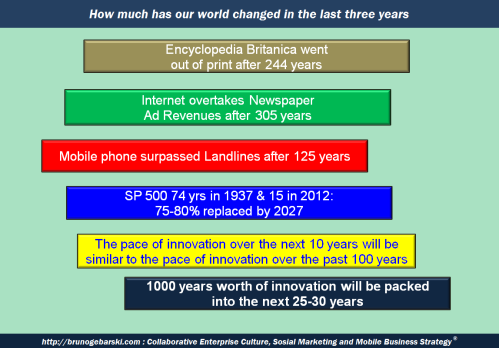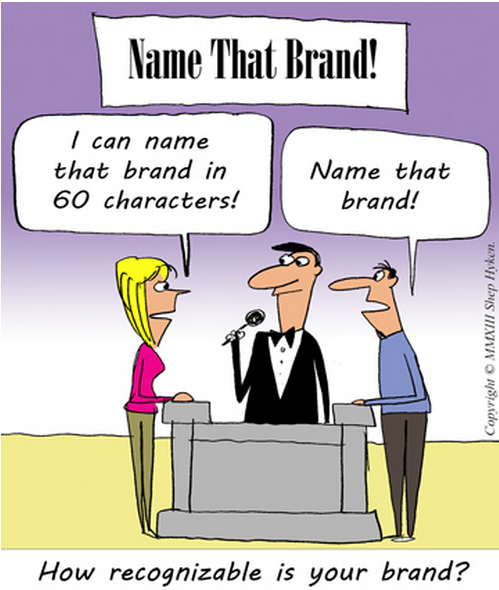We are living in a ubiquitous mobile era and by the way, don’t we love it? Could you imagine for a second a world without smartphones or tablets? Sooner than later we will start out our day by reading our favorite newspaper while shaving in front of the bathroom mirror. We’ll continue reading while listening to our car audio system driving to work, then on to our Google glasses while walking to the office, finally catching up with the last paragraph either on our tablets, smartphones, laptops or antiquated PCs.

The Guardian reported on February 22: “Mobile and social are bringing a dramatic cultural shift to the enterprise. The combination of mobile technology and social capabilities creates dynamics that have never before been possible.”
How can we synthesize the major technical trends that have transformed the way we live and the way we work? In the last 10 years broadband communication has brought upon us three major changes: mobile, social and cloud.
1. Mobility
“Gartner predicts that by 2013 mobile phones will overtake PCs as the most common Web access device worldwide and that by 2015 over 80 percent of the handsets sold in mature markets will be smartphones. By 2015 media tablet shipments will reach around 50 percent of laptop shipments and Windows 8 will likely be in third place behind Google’s Android and Apple iOS operating systems.”
Our digital world citizens have acquired more than one billion smartphones in 2011 and 2012 combined, with a 10.10% increase from 2011 (495.3 million units) to 2012 (545.2 million units). By 2015 there will be 4.9 billion global mobile users. Those figures are staggering and prove the “smart” mobile shift happening right now in our society. Our mobile trend opens incredible new business models and opportunities such as mobile marketing, mobile payment, near field communication (NFC), indoor navigation systems and finally 25 billion apps, which have been already downloaded (iOS and Android).
2. Our 21st century social network society
Less than 10 years ago (2004) Mark Zuckerberg launched Facebook, a social network that would turn the way we communicate upside down. The membership has passed one billion worldwide and forever changed our notion of privacy. Less than ten years ago it would have been inconceivable to post pictures on a public domain for just about anyone to see, while Google crawlers constantly index the web to improve the company’s search prowess. Suddenly people are capable of staying in touch with their friends, while uploading their latest picture hunt they proudly want their communities to see. Meanwhile, other social tools have popped up:
- LinkedIn — the 200 million professional network was created in 2002
- Twitter — the micro-blogging site was started by Mike Dorsey in 2006
- Caterina Fake’s Flickr image posting tool goes back to 2004
- YouTube, created by former PayPal employees, was launched in 2005
- Skype, a proprietary Voice over IP (VoIP), was first released in 2003
and the list goes on and on. Business Insider reports on March 21, 2013: “YouTube hits 1 Billion Monthly Users”, a staggering number of people viewing, uploading and sharing videos from the four corners of our planet. Mobility is allowing communication in real-time, whenever and wherever it happens! Traditional structures are being by-passed, new business models are being created. What is going to happen to our libraries? Virtual worlds and virtual goods can now be created. What would happen if one day Facebook decided to create its own currency? Whatever, wherever, whenever is becoming the new norm of ubiquitous digital communication thanks to broadband technology.
Sharing information on all sorts of platforms (notebooks, smartphones and tablets) is forcing us to centralize our data storage. How else would we access our Twitter, LinkedIn or Facebook accounts if all the data had to be stored separately and constantly synchronized, as we used to do it between our PCs and Notebooks?
3. Cloud computing to the rescue
Without cloud computing it would be impossible for any of us to own a Google email account, impossible to tweet or to review and update the content of our LinkedIn accounts. It is estimated there is one exabyte of data stored in the “cloud”. All our favorite Evernote bits and pieces are stored in the cloud, so are our Facebook pictures, Twitter favorites and Slideshare presentations. Additionally, many of us are now moving some our personal data (traditionally stored on hard disks) to cloud services such as Box.com, Dropbox and many others. Cloud services such as Amazon Web Services (AWS), Mountain Lion’s Apple operating system, introducing services such as iCloud, are popping up everywhere.
Consequently, cloud computing has allowed us to centralize the positioning of our personal data and to access it from any “Bring Your Own Device (BYOD) of our choice, thanks to broadband technology supporting our relentless nomadic lifestyles. Cloud is the engine, the door opener, the way, the modern broadband electricity trail seamlessly granting access to our data, whenever and wherever we want it. In 1917 Sears ran an advertisement advising people to “use electricity for more than light”. At the beginning of the 21st century cloud computing technology is here but still in its infancy. Nikola Tesla (Никола Тесла; July 10 1856 – January 7th 1943), a Serbian-American, was the inventor of the modern alternating current electrical supply system. As much as electricity would prove to be much more than powering light bulbs, cloud computing gives us the feasible prospect of eliminating local data storage! Do you know of anyone storing their own electricity? Sounds ludicrous right? It could very well become the same with cloud computing. Buckle up, it’s going to be an interesting ride. Our children and native digital citizens will someday look at us wondering how on earth we lived without cloud storage, smartphones and broadband communication — the new digital highway of our 21st century wireless, “clouded” and crowded world.

Photo Credit: http://en.wikipedia.org/wiki/Cloud_Computing
0.000000
0.000000
















